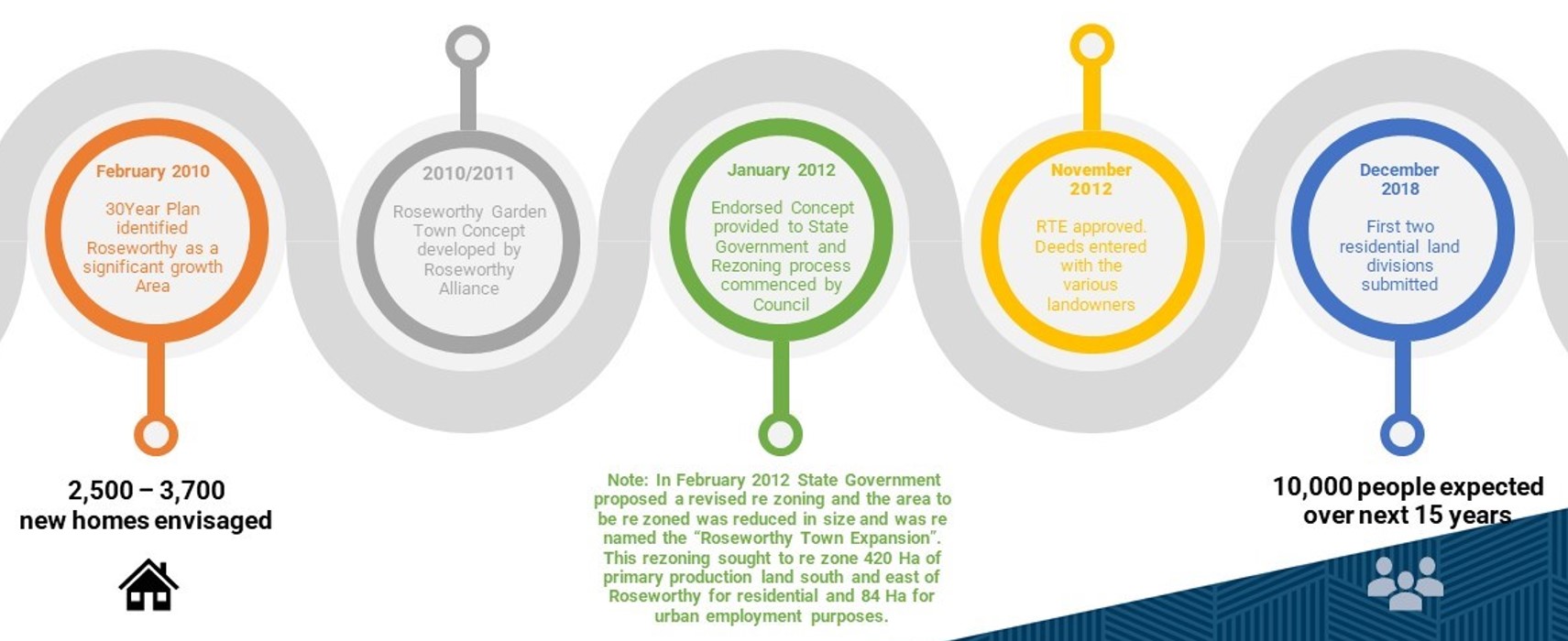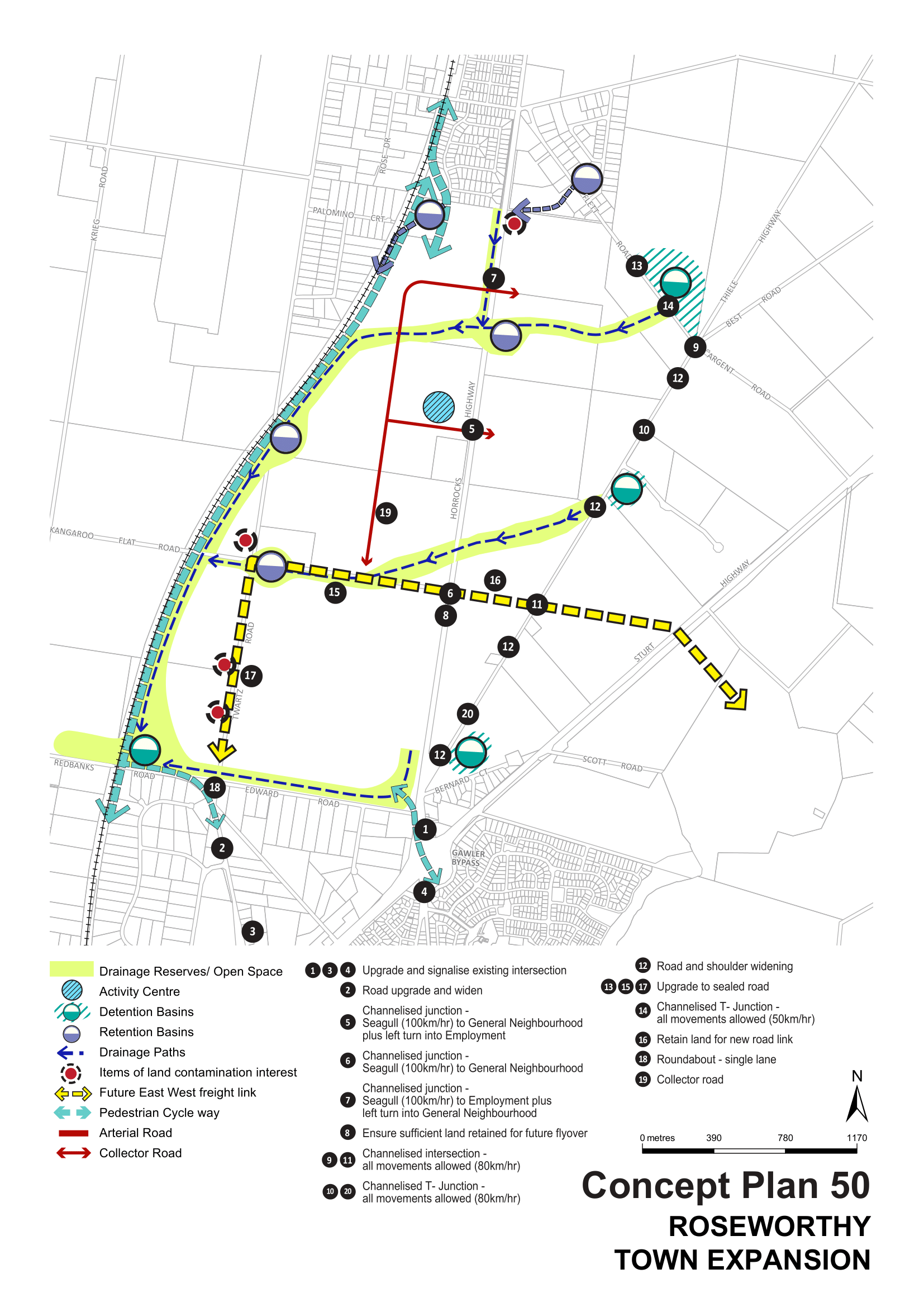Roseworthy Township
On 13th December 1837, the Surveyor General of the Colony of South Australia, visited the area which would eventually become the township of Roseworthy.
In 1855, William and Grace Gartrell purchased land in the Hundred of Mudla Wirra. When her husband died in 1863, Mrs Gartrell subdivided the land for a township and named it Roseworthy after a village in Cornwall. The name Roseworthy is derived from Roswartha, meaning Meadow Heath.
On 5th July 1869, Roseworthy became a major rail link for passengers travelling to and from Morgan, Gladstone and Terowie. The station also became an important junction for the link to Kapunda and Burra.
In 1881, the government purchased land to establish an experimental farm in the region and in 1883, reconstituted the farm as a college. Roseworthy Agricultural College became the first of its kind in Australia and is now a major contributor to agricultural teaching and research.
Roseworthy is a thriving community in a region recognised for its significance in the wine, grain and sheep industries.
Roseworthy Township Expansion
The Roseworthy Township Expansion (RTE) moved from planning to on-ground works during the 2020/21 financial year, after a very long lead time (see figure below). Highlights of that first year included:
- Turning of the first sod to commence works within the RTE
- Completion of the St Yves intersection with Horrocks Highway, and
- Pouring of the first house slab (6th May 2021).

Since then, progress has been swift, fuelled by a housing boom in SA.
At any time, you can check out what land divisions have been proposed or approved to-date at the RTE, by using the mapping function of the SA Planning Portal. Just zoom in to Roseworthy and switch on the 'Land Division Applications' layer (under 'Planning and Building > Development Applications').
There are 3 developers currently active at RTE across 5 housing estates:
- https://www.styves.com.au/
- https://roseworthygarden.com.au/
- https://villawoodproperties.com.au/community/william-lakes/
Further, St Yves will incorporate a new community oval and a campus of Trinity College.
The Concept Plan below is available from the SA Planning and Design Code website and illustrates the starting point for assessment of development applications in the RTE precinct.
Light Regional Council plays a number of roles across the RTE:
- Assess Development Applications (incorporating Land Divisions).
- Administer the infrastructure deeds for the RTE to ensure road, stormwater and social infrastructure outcomes are delivered through the development phase. These infrastructure deeds secure the developer funding of the infrastructure required.
- Accept public realm assets like streets, ovals, street lighting etc once delivered to an appropriate standard by developers.
Light Regional Council seeks to collaborate with landowners and utilities across the RTE and Kingsford precinct to realise optimum infrastructure outcomes for our future community and employers in this growth precinct.
One of these key areas of collaboration is stormwater harvesting and provision of a non-drinking water supply for irrigation of public spaces and industrial use. As such, Council is very excited to have secured Federal and State Government co-funding to progress a Public-Private Partnership project called the Roseworthy Water Scheme that will seek to deliver these outcomes for region-wide benefit.
For further information about the Public-Private Partnership project, refer to the Roseworthy Water Scheme page.
RTE Frequently Asked Questions (FAQs)
Has the Roseworthy Township Expansion been approved, and if so, what was the process for this approval?
- The rezoning of the area in question aligns with the State Government’s Planning Strategy and was approved by the Minister for Planning in November 2016 via the Roseworthy Township Expansion Development Plan Amendment (RTE DPA). This process was the culmination of many years of work with both the landowner group, the Roseworthy Alliance and the wider community which resulted in the compact expansion of Roseworthy.
What are the future steps in the development assessment process?
- The finalisation of rezoning of the area in late 2016 marked the final step in the process to set the zone policies for the expansion of the Roseworthy Township.
- The initial essential infrastructure deeds have been settled and executed between the landowners and the Council - these relate to road, stormwater and social infrastructure required at RTE.
- The finalisation of zoning and execution of deeds has enabled Council planning staff to commence receipt and assessment of land division applications from multiple landowners across the RTE.
- In assessing these (or any) applications, Council Officers operate within the confines of the relevant Acts and Regulations (Development Act 1993, Development Regulations, 2008 and Planning, Development and Infrastructure Act, 2016). Applicable conditions, requirements and standards will be applied in time to ensure development occurs in an orderly and efficient manner and within the confines of the relevant legislation.
- RTE developers are also guided on Council's expectation via the RTE Infrastructure Style Guide.
What infrastructure will be built to accommodate the expanded population at Roseworthy, and who will pay?
- The delivery of key regional infrastructure in the form of major road works, stormwater works and social/community infrastructure to support the new community has formed an integral part the RTE DPA process. These elements have been secured via Infrastructure Deeds with all landowners within the RTE zone and will see these landowners responsible for the provision of this infrastructure.
- In addition to roads and stormwater infrastructure, these deeds guide the delivery of such social infrastructure as a sports oval complex, including lighting, basketball/netball/tennis courts, and cricket training nets. Other social infrastructure beyond the oval includes provision of a shared-use path (bicycle and pedestrian walkway) within the development with potential for a link to Gawler.
- With regard to the oval at St Yves, this will be a shared use facility in accordance with this Community Land Management Plan (CLMP). In summary (copied from the CLMP) - "At the time of preparing and adopting this CLMP the Land is undeveloped, however it is proposed that the Land will be developed into a sporting and recreational facility for the use and benefit of the community and the adjacent school (to be developed). This CLMP is intended to allow for both the development of the Land and for its ongoing management and use as a public recreation reserve".
How will Council ensure that the infrastructure handed over by the RTE developers on completion is of an appropriate standard?
- Council has established an internal “RTE Infrastructure Task Force” to ensure Council’s advice to, and collaboration with developers is coordinated across Council’s various functions.
- This Task Force will focus on critical infrastructure, such as roads, water management, social infrastructure, energy supply to the region, and Smart Cities strategies.
- The RTE Infrastructure Task Force will continue to collaborate, negotiate and resolve infrastructure issues as they arise with developers, without compromising Council’s statutory planning obligations in assessing RTE Land Division and Development Applications.
- In terms of infrastructure standards, Council assesses applications in accordance with The Institute of Public Works Engineering Australia, South Australian Division’s “Infrastructure Guidelines SA” (eg. stormwater, footpaths, roads, sewer, water, parks etc).
- RTE developers are also guided on Council's expectation via the RTE Infrastructure Style Guide.
How big will the housing allotments be in the Roseworthy Township Expansion?
- The RTE Master-planned Neighbourhood Zone forms part of the State Government’s ‘library’ of applicable zones and supports both a mix of activities and allotment sizes.
- The desired character statement for the RTE Master-planned Neighbourhood Zone states that… “Development within the zone will be designed to provide allotments with an overall average area in the order of 700 square metres, transitioning from medium density adjacent to open space areas and the activity centre to low density (in the order of 1000 to 1500 square metres) at the western boundary along the railway line and drainage corridor”.
- The ultimate average size of the blocks, once the RTE is complete, will be dependent on a combination of market drivers and application of the above “desired character statement” to the assessment of each land division application. Initial applications indicate that an average lot size for a number of developers is in the order of 500-550sqm.
How will the design of this new housing development cope with our hot and dry summers?
- Development applications will be assessed in accordance with the relevant planning and building codes, which have minimum requirements for such matters as energy efficiency.
- Council’s RTE Infrastructure Taskforce is also currently working collaboratively with Land Vision Group (St Yves), Villawood Property Group (William Lakes) and the Hickinbotham Group (Roseworthy Garden) to progress holistic water management for the RTE. As a result of these discussions, the following “water vision” has been developed for the RTE, to guide planning and assessment:
- “Roseworthy as a catchment: Stormwater from the Roseworthy township will be reused…
- at-source/passively for irrigation and urban cooling
- at precinct-scale for public realm benefits
- at a regional-scale for production of wine or food
- Wastewater from the Roseworthy township will be reused in the Northern Adelaide/Barossa region for production of wine or food.
- Roseworthy as climate-aware, resilient and adaptive:
- At-source stormwater use for shade trees and localised cooling
- Fit-for-purpose match of water source to use
- Water and energy-efficient irrigation and water infrastructure
- Low carbon energy sources
- Roseworthy as a showcase for ‘Smart’ Water Management, Technology & Financing”
- “Roseworthy as a catchment: Stormwater from the Roseworthy township will be reused…
How will stormwater be managed from an expanded Roseworthy?
- The RTE area is a part of a broader catchment that extends to the north-east and in high rain fall periods has traditionally drained towards low-lying parts of Gawler Belt (this has been the subject of a related Stormwater Management Plan, currently being finalised by the Town of Gawler, in partnership with Light Regional Council).
- As RTE development progresses, stormwater runoff from RTE will be retained on-site to pre-development levels, noting that the developed catchment will change how flows behave. Upstream catchment stormwater flows will pass through RTE and thus downstream receiving environments such as Gawler Belt will continue to receive stormwater flows from this area, as it has historically.
- While the RTE is being developed, stormwater will follow these traditional paths expected within a saturated catchment, until such time as developers progress to such a stage that flows follow the paths indicated on the Concept Plan above.
- Stormwater basins within each developer's estates will sometimes fill up and over-top, particularly in wetter-than-average periods. This does not necessarily mean that these basins are operating beyond their design intent (be that as a final wetland for the development, or stage-by-stage interim basin).
- The Roseworthy Water Scheme (see figure above outlining the expansion of the Gawler Water Reuse Scheme), as a key part of implementing the RTE Stormwater Infrastructure Deed, will connect to wetlands at the low-point of each developer's estate to play a critical role in:
- formalising stormwater management across the RTE,
- minimising nuisance flooding within the RTE area, and
- ensuring flooding is not exacerbated on the southern side of Redbanks Road (Gawler Belt).
What public transport will be available for residents of an expanded Roseworthy?
- It is envisaged that some form of “last mile” connection will ultimately link Roseworthy to Gawler, and more specifically, one of the existing Gawler Railway Stations.
- Council will continue to discuss these matters with RTE landowners, the State Government, the Town of Gawler, and OneRail Australia (who have care and control of the currently disused Gawler-Roseworthy rail reserve from the State Government).
Will this mean that Gawler and Roseworthy eventually join up as one metropolitan area?
- Whilst recognising that the Roseworthy Township Expansion Area will see urban and commercial/industrial growth occur between the Gawler Belt rural living area, Hewett and the existing township of Roseworthy, the rezoned land represents a consolidation of growth in accordance with the Planning Strategy that avoids creating fragmented development on the edge of the urban area.
- However, it should be noted that Sturt Highway and the Rural Living area of Gawler Belt will continue to provide a distinct demarcation between Roseworthy and Gawler/Willaston.
Does the University of Adelaide Roseworthy Campus have anything to do with the Roseworthy Township Expansion?
- There is approximately 5km of sealed road between the University of Adelaide Roseworthy Campus and the RTE.
- Light Regional Council has met with various University of Adelaide representatives to explore the following possible connections between an expanded Roseworthy Township and the University campus:
- Physical connections, eg. public transport, roads, cycle paths, collaboration spaces, student/staff accommodation, oval sharing etc.
- Connections though knowledge development and testing.
- Entrepreneurial / commercialisation opportunities.
- These conversations have been very positive to-date, and shall continue as required.
- Future conversations with University of Adelaide will include consideration of opportunities arising from the establishment of Trinity College as the school for the RTE Activity Centre.
Will the RTE development negatively impact on the Council’s financial position?
- New developments provide additional rating revenue to Council, however they also come with demands for a range of services and future infrastructure replacement needs which do come at great cost. Compared to Council’s existing townships, which were typically first settled in the late 1800’s, the RTE is likely to have higher service level demands with modern infrastructure handed over by Developers, which can create challenges for the Council’s financial sustainability.
- The Council has utilised the Local Government Finance and Economic Impact Model, developed by renowned economic experts Deloitte Access Economics, to model the RTE development from a financial sustainability perspective. This tool has enabled Council to assess the key drivers that will ensure the township expansion is sustainable in its own right, and not reliant on rating revenue from existing ratepayers. Whilst the model is currently at a high level, as more detail about individual stages and subdivisions become available, it will be refined such that Council can focus its development assessment process and rate setting strategies to achieve the financial sustainability that is important to all ratepayers.
- The financial modelling tool was instrumental in negotiating the infrastructure deeds with Developers and will also be critical in future negotiations on topics such as shared use agreements between public and private parties associated with community spaces and assets.

